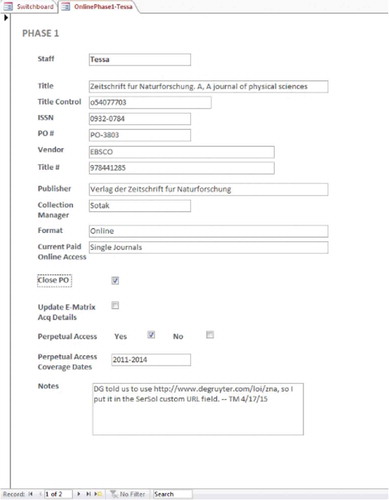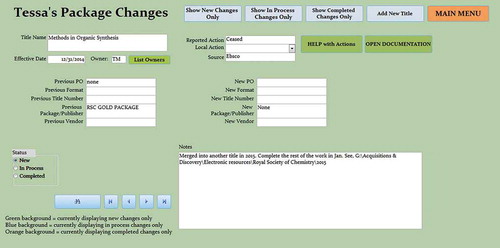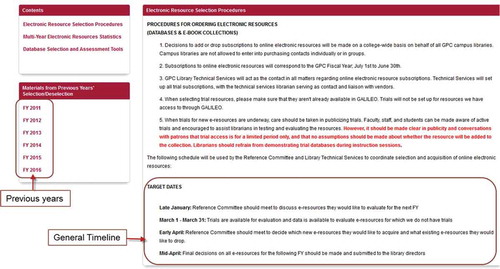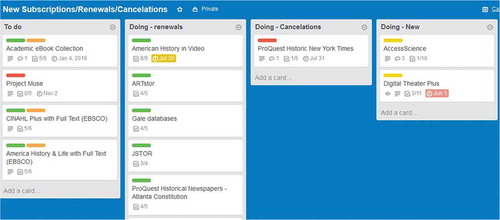Abstract
On the surface, it might appear that libraries with different collections, staffing levels, and budgets would have to make use of different tools to address their e-resource management needs. However, in their review of electronic resources lifecycle work at North Carolina State University and Georgia Perimeter College, Tessa Minchew and Sofia Slutskaya discovered that this is not always the case. The presenters reviewed the electronic resources lifecycle and three distinct types of tools (content management systems/wikis, Microsoft Access, and Trello) that are being used in different ways to address different lifecycle-related tasks at each of their institutions.
Managing electronic resources is a task challenging enough to lend itself to numerous old saws, “herding cats,” “keeping the plates spinning,” and the like. With so many projects competing for a seemingly ever-shrinking funding base, acquiring electronic resources management tools is often not a high priority at administrative levels for small and large institutions alike. Commercial electronic resource management (ERM) products are expensive, often require at least some form of technical support, and still do not seem to be able to live up to the heavy demands placed on them. To top it all off, there is no one application that can adequately support all of the tasks associated with every stage of the electronic resources lifecycle, and there probably should not be as that application would have to be so complex that it would present a high barrier to entry for its users. Thus, finding the correct array of free or low-cost tools and adapting existing ones to new purposes have become vital skills in the management of electronic resources.
THE LIFECYCLE AND TOOLS THAT MANAGE IT
Selecting the appropriate tools to support e-resource management requires a thorough understanding of the e-resources workflow and lifecycle. So, Minchew and Slutskaya began their session preparation by reviewing the “NASIG Core Competencies for Electronic Resources Librarians”Footnote1 and Pesch’s e-resource lifecycle diagram in particular.Footnote2 During their review, Minchew and Slutskaya noticed that, as comprehensive as Pesch’s lifecycle diagram is, there are still aspects of e-resource management that are not covered by it. Thus, they were vividly reminded of how the work associated with managing electronic resources is complicated, convoluted, and individually tailored at the institutional and often even the departmental or unit level.
The presenters were also struck by the importance of selecting tools that facilitate and support internal and external communications and those that provide a record of e-resources management processes, decisions, communications, and workflows. Flexibility and scalability are also extremely important considerations. Tools should be able to adapt and scale well enough so that their use does not have to be abandoned if there are organizational structure or workflow changes. When discussing all these issues, the presenters quickly realized that reviewing the same tools being successfully used on greatly different scales at their respective institutions would demonstrate all these points quite well. They began their presentation with overviews of the North Carolina State University (NCSU) and Georgia Perimeter College (GPC) libraries to establish a foundation for a comparison of the tools that are being employed to support e-resources management in both institutions.
INSTITUTIONAL OVERVIEWS
NCSU is a research institution located in Raleigh, North Carolina. The institution has three physical campuses, numerous online programs, and, as of Spring 2014, a headcount of 28,618 students (full-time equivalent [FTE], 26,167). In FY2013, NCSU Libraries spent over $7,750,000 on electronic resources. With approximately 470 managed databases, 8,100 managed e-journal subscriptions, and 827,698 e-books (not counting its collections of datasets, digital images, and streaming media collections), NCSU Libraries collections are large and varied. (Counts of “managed” databases do not include direct subscriptions, aggregator titles, etc.) In addition, NCSU Libraries is a member of NC LIVE, a consortium supporting 200 member libraries (academic and public) throughout the state. NC LIVE offerings expand the NCSU Libraries’ collections to include an additional seventy-eight databases and 192,597 e-books and e-journals. Unsurprisingly, electronic resources management tasks at NCSU Libraries are also complex and varied. NCSU Libraries’ technical services department, Acquisitions & Discovery (A&D), is responsible for all ERM tasks. This work is distributed (to varying degrees) between the department head, five full-time librarians, and seventeen full-time employees who staff the three departmental units (Serials, Monographs, and Data Projects and Partnerships). All staff are cross-trained in acquisitions and cataloging, reducing the number of handoffs of work between staff and greatly increasing efficiencies.
GPC is a state college in metropolitan Atlanta, Georgia, with five physical campuses and an online “campus.”Footnote3 In the fall semester of 2014, GPC’s FTE was 15,500 and its enrollment was 21,371 with 8,000 of these students being enrolled in at least one online class and approximately half of that 8,000 attending exclusively online. To meet the needs of their community, GPC Libraries locally manages twenty-three databases and approximately 100,000 e-books. They have access to an additional eighty-six databases, 30,000 e-books, and 20,000 streaming media items through the statewide consortium, GALILEO. GPC Libraries’ annual e-resources expenditures typically average out to $100,000. Each GPC campus has its own library and all five libraries combined employ a total of twenty-one full-time librarians and thirteen full-time staff. GPC Libraries’ technical services operations are centralized on the Clarkston campus, in the Library Technical Services department. The Technical Services department, consisting of three full-time librarians and three full-time staff, is responsible for acquisitions, cataloging, and processing of all print and electronic materials for all GPC campuses. The majority of all e-resources management tasks are performed by a single librarian, Sofia Slutskaya.
DISCOVERY OF SHARED TOOLS
As previously mentioned, when considering the e-resources management work being conducted at each of their respective institutions, Minchew and Slutskaya discovered they were using several of the same tools to facilitate various stages of the lifecycle. For their presentation, they decided to focus on three general tool groups: (1) Microsoft Access databases; (2) Content management systems (CMS) & Wikis; and (3) Trello boards.
MS ACCESS: GPC LIBRARIES & ERMES
Microsoft Access is a ubiquitous database management system readily available in most libraries running the Microsoft Office software suite. Therefore, pressing it into service as an e-resource management tool should require no additional cost, installation work, or technical support. Libraries with database-savvy staff will find that they have a lower barrier to entry with Access than other libraries that may not already have these skills present in their workforce. However, the software is well-established, free training resources are plentiful, and our professional community is well-known for being generous with its time and resources.
Case in point, ERMes, a free Access-based electronic resources management tool developed by librarians from the Murphy Library at the University of Wisconsin–La Crosse.Footnote4 Having limited financial and technical resources, but plenty of PCs equipped with Microsoft Office, GPC Libraries was excited to discover ERMes. GPC Libraries does not have any in-library information technology (IT) staff. As such, they must rely on the college-level IT department which is often understaffed and overextended. Having a database that can be run locally or on a shared drive, as opposed to an ERM that needed to be installed and maintained on a server, was ideal for this situation.
The ERMes database requires Access 2007 or higher and is well-suited for small organizations where only one or two people are responsible for e-resources management tasks. It can be used “right out of the box” with no customizations, so it only requires a minimal level of familiarity with Microsoft Access. ERMes successfully manages databases, e-journals and e-books on package level, but it does not scale well to title-level management. It also does an admirable job of tracking administrative information, administrative credentials, and contact information, but it cannot track steps in a workflow or create action alerts. Based on the local situation, a librarian can decide to use all or only a few available features. Basic reporting functionality is also built in, making simple reports like payment history or year-by-year price comparison available (see ).
GPC Libraries uses ERMes for basic e-resources management tasks, including collecting high-level information about vendors and databases and tracking payments, renewal dates, links and passwords for access to vendor-provided usage statistics. The most frequently used standard ERMes reports are the Payment History and the Year-to-Year Price comparison. As Sofia Slutskaya handles all of GPC Libraries’ e-resource management work, their ERMes database is only installed on her office PC.
MS ACCESS: NCSU LIBRARIES’ CANCELLATIONS AND PACKAGE CHANGES
NCSU Libraries uses numerous Access databases to manage various stages of their e-resources lifecycle, but the size of the library organization and its collections does not lend itself well to a tool like ERMes. Fortunately, the Acquisitions & Discovery department has several talented staff members who can create Access databases to meet departmental needs, in addition to an entire unit (Data Projects & Partnerships) whose mission is, in part, devoted to supporting the work of A&D through tool development.
Journal cancellation projects are a sad task that most serials librarians will have to face more than once in the course of their careers. In late 2013, NCSU Libraries was told to expect $750,000 in cuts to its Fiscal Year (FY) 2014/2015 collections budget (about 7.5% of the 2013/2014 allocation). In early September 2014, 750 journals were selected for cancellation along with 100 databases. An Access database was constructed to support the cancellation work, which was distributed across seven staff members in the serials unit.
The database provided queues for each staff member which were divided by the format of the cancellation (print, online, and print plus online) and then separated into two phases. Details of each title being cancelled were contained in an individual form (see ). A review of the completed cancellation work revealed that only 2 of the 850 cancellations had not been handled 100% accurately, which is a testament to both the skill of the staff involved and the effectiveness of the Access database used to manage the process.
The journals cancellation database was used for a one-off project that NCSU Libraries hopes to not have to repeat any time soon. However, there are other Access databases being used to support ongoing work, a fine example being the package changes database. A&D package management tasks include ordering, licensing, access setup and maintenance, title changes, and renewals. These tasks are divided between the seven staff members of the serials unit, each of whom is assigned one or more packages to manage. A&D currently manages twenty-one active packages and the end result of that is a continual flow of package changes. Prior to 2015, package changes were compiled and distributed to staff in an Excel spreadsheet. By 2015, it had become apparent that a more robust tool was needed and an Access database began to be piloted for this work.
The dashboard of the package changes database initially divides queues up by staff member. After clicking their name, the staff member is taken directly to a series of forms, each one documenting an individual title on which some action may need to be taken and the information available about it (see ). The work was divided into two phases and contextual documentation was provided within the database. In addition, the package changes database feeds a spreadsheet in which the serials unit tracks statistical information about subscription changes, so the tool is performing double duty. The package changes database has great potential as a management tool, but it is still in a pilot phase and changes are being planned that should continue to improve its structure and efficiency.
CMS AND WIKIS: NCSU LIBRARIES’ ELECTRONIC RESOURCE HUB
Wikis and content management systems (CMS) are excellent places to store e-resource management documentation. If they are installed at an institutional level, all staff already have access to them and at least some basic level of familiarity with them. NCSU Libraries is currently using an older version of the wiki software Confluence to run its staff intranet, so A&D already stores a large amount of documentation there and it was a logical place to house the Electronic Resources Hub.Footnote5 Prior to 2011, information related to the management of e-resources was spread across multiple wikis, paper files, and shared drive directories. It was readily apparent that this information needed to be corralled into a single easily-digestible container. The Electronic Resources Hub emerged as a dashboard environment that tracks or links to all the information related to the purchase and management of e-resources at NCSU Libraries.
The Hub compiles documentation relating to electronic continuing resources and e-books, information about the NC LIVE consortium, licensing, and some of the other tools used in e-resources management such as the Serials Solutions knowledgebase. Some of the most heavily-used sections of the Hub are the package spaces (see ). Each package space contains title lists, discussion logs, package calendars, and a package profile which is intended to be a snapshot of higher level package information (license details, acquisition information, business terms, etc.). Package profile pages are heavily used, not just by staff in A&D. NCSU Libraries collection managers also refer to these pages to make decisions about their collection areas without having to dig through the ERM or contact A&D staff just to get fast facts.
CMS AND WIKIS: GPC LIBRARIES AND LIBGUIDES
Launched by Springshare in 2007, LibGuides is an affordable, user-friendly content management system that is was initially designed primarily to support library instruction and to create library websites and online pathfinders to library resources.Footnote6 The LibGuides web-based interface makes it simple to publish, edit, and reuse content in a collaborative environment. This allows for both the dissemination of information and the maintenance of an institutional record, making the CMS ideal for supporting internal library processes such as committee work and e-resources management activities. Like the wikis being employed to run many library intranets, LibGuides is already available in many libraries and many library employees are comfortable using it. Security features allow users to make some information publically available while password-protecting more sensitive pieces of data. Libguides is also scalable, making it a suitable application for institutions with teams working on e-resources management and for those with just a single e-resource librarian.
In her role as GPC Libraries’ e-resources librarian, Slutskaya uses LibGuides to document and disseminate information about e-resources subscriptions, and to facilitate the subscription and cancellation workflow with the goal of simplifying the selection and evaluation process for public services librarians making selection and deselection decisions (see ).
In these guides, she includes an e-resources selection timeline, a record of current trials with supplemental information such as title lists, prices, and so on, and easy access to the usage statistics of the resources being evaluated. To simplify management of the process, e-resources trials are all run on the same schedule and the list of trials and their evaluation forms are published on a LibGuide open to all librarians and faculty involved in evaluation. The LibGuide thus becomes a central reference point during the decision-making process.
TRELLO: NCSU LIBRARIES’ LICENSING AND PACKAGE MANAGEMENT BOARDS
Trello is a free, cloud-based, project management application that allows users to track a project on a highly customizable web page called a board. Each board will have one or more members, and can contain one or more lists. Lists are comprised of one or more cards, and each card can contain a wealth of data including members involved in the task, time-stamped comments, attachments, labels, due dates, and checklists. The checklists are particularly helpful for tracking complex workflows such as those associated with licensing.
In late 2013, the serials unit of NCSU Libraries A&D began piloting the use of Trello beginning with boards devoted to tracking unit projects and package management activities. The appeal of using Trello to track the complex licensing process quickly became apparent and a board was created for the A&D license team. After a short pilot, license tracking was moved from Confluence to Trello (see ). To ensure that all stakeholders still had access to information about ongoing license negotiations, an account was created to allow Collection Management to view the license team board and by end of FY 2013 license tracking had been moved exclusively to Trello. As of the writing of this article, NCSU Libraries is using Trello to track unit projects, plan unit meetings, track package management and licensing workflow, and track action items for working groups.
TRELLO: GPC LIBRARIES’ E-RESOURCE TRIALS AND NEW SUBSCRIPTIONS/RENEWALS/CANCELATIONS BOARDS
GPC Libraries use Trello boards to support internal e-resource management tasks and to keep a record of communications with vendors and other external players. Currently GPC Libraries has two boards, one to track trials and the second to document new subscriptions, renewals, and cancellations (see ). Both boards utilize checklists and labels.
The checklists on each card are organized to track different types of activities such as communications with a vendor, setting up access, communications with reference librarians, e-resource marketing, and so on. Labels are used to distinguish between new resources, renewals, and cancellations, and also between different types of subscriptions (locally managed or consortial). Trello allows filtering by label, so cards can easily be limited to only those associated with a specific label, allowing for a more tailored view of the information. The Trello notifications feature generates e-mail reminders prior to the due date set for specific cards and the calendar view provides an easy overview of the tasks that need to be completed in a specific month.
CONCLUSION
Clearly, when it comes to e-resource lifecycle management tools, vastly different institutions really have much more in common than they might think. Thus, the presenters would like to emphasize the importance of opening up to collaboration outside of one’s own institution. Collaboration with wider circles of colleagues is not only beneficial for the professional community as a whole; it also increases everyone’s opportunities to learn about new applications to support their work and about previously untapped options for making better use of existing applications.
Additional information
Notes on contributors
Tessa Minchew
Tessa Minchew is Electronic Resources Librarian, North Carolina State University, Raleigh, North Carolina, USA.
Sofia Slutskaya
Sofia Slutskaya is Technical Services Librarian, Georgia State University – Perimeter College, Clarkston, Georgia, USA.
Notes
1. “NASIG Core Competencies for Electronic Resources Librarians,” NASIG, http://www.nasig.org/site_page.cfm?pk_association_webpage_menu=310&pk_association_webpage=1225 (accessed July 30, 2015).
2. Oliver Perch, “ERMs and the E-Resource Life-Cycle [Powerpoint slides].” Rome, March 2, 2009, http://tinyurl.com/ERLifeCycle (accessed July 30, 2015).
3. In January 2016, Georgia Perimeter College consolidated with Georgia State University to become Georgia State University – Perimeter College.
4. Information about ERMes can be found at http://murphylibrary.uwlax.edu/erm/.
5. Information about Confluence can be found at https://www.atlassian.com/software/confluence.
6. Information about Springshare can be found at http://www.springshare.com/.







